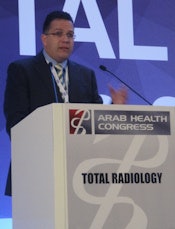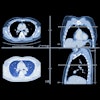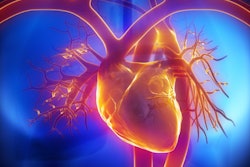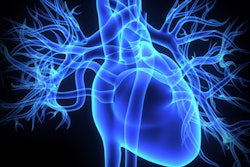
DUBAI - CT is now the gold standard for ruling out coronary artery stenoses and coronary anomalies. It can also be useful for coronary artery bypass graft and electrophysiology studies, as well as investigations of pulmonary veins, delegates learned on the opening day of Arab Health.
However, MRI is generally the preferred technique for examinations of cardiac veins, congenital heart disease, and morphology/cardiac masses and for function/valvular assessment, as well as late enhancement studies, said Dr. Ahmed Samir Ibrahim, an associate professor of radiology at Ain Shams University in Cairo.
 Ischemic heart disease keeps rising and is likely to cause 20 million deaths worldwide by 2020, Dr. Ahmed Samir Ibrahim said.
Ischemic heart disease keeps rising and is likely to cause 20 million deaths worldwide by 2020, Dr. Ahmed Samir Ibrahim said.The key requirements for cardiac and coronary CT are reduced motion artifacts, enhanced spatial resolution (coronaries are 2 mm to 5 mm), enhanced contrast resolution (to identify soft plaques, for example), reduced total scan time (less than one breath-hold), and reduced radiation exposure (not more than in coronary angiography).
"With the evolution of CT machines, we are able to cover the whole heart in one or two rotations, which is really amazing, and decrease the contrast and radiation dose greatly, while increasing the spatial resolution and image quality," he said.
Evidence is mounting that coronary CT angiography (CCTA) is a robust noninvasive method to assess coronary artery disease, and, furthermore, treatment guided by fractional flow reserve (FFR) can improve patient outcomes and reduce healthcare costs. It can also lead to a 25% improvement in the diagnostic accuracy of cardiac CT, Ibrahim noted. The ongoing Platform study, which began last year, promises to reveal more about FFR measurement using CCTA, following the Discover-Flow study from 2011 and the Fame study from 2009.
In an article published online on 15 April 2014 by Nature Reviews Cardiology (Vol. 11, pp. 252-254), lead author Dr. Javier Escaned, an associate professor of cardiology at the Universidad Complutense de Madrid School of Medicine, asked whether CT-FFR would replace old indices of coronary stenosis severity. Recent research suggests that old indices of angiographic severity used in clinical practice, such as percentage diameter stenosis, might become obsolete, according to Ibrahim.
Also important here is the special issue of the Journal of the American College of Cardiology for the Annual Symposium of Transcatheter Cardiovascular Therapeutics (TCT) in September 2014, he said. Cardiovascular CT may become the primary imaging test, and CT-FFR, plaque characterization, perfusion, and spectral imaging could tip the balance in favor of CT as the primary cardiac modality, the authors speculated.
"Ischemic heart disease keeps going up and up, and it is estimated it will cause 20 million deaths worldwide by 2020," he said. "The question is: What about chest pain and how do we manage it? Should we go for ECG, echo Doppler, stress ECG, stress isotope, coronary angio in conventional labs, invasive cath intervention, or multidetector CT?"
CT is gaining the upper hand against all these other procedures, and consensus is growing that CT's diagnostic role is an excellent tool for assessment of coronary artery disease, he explained. Qualitative and quantitative assessment of atherosclerotic coronary stenosis with CCTA has been favorably compared with invasive coronary angiography and intravascular ultrasound, and, significantly, it facilitates the study of preclinical stages of atherosclerotic disease, can help improve risk stratification, and monitor the progressive course of the disease.
Moreover, CCTA is useful in predicting clinical outcomes based on the extent of coronary atherosclerosis and also based on individual plaque characteristics, such as low attenuation plaque, positive remodeling, and spotty calcification, he concluded.




















